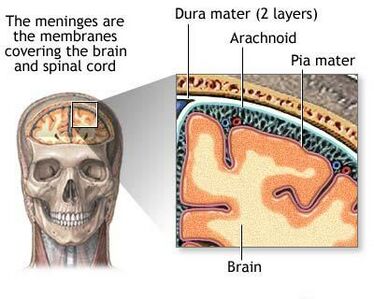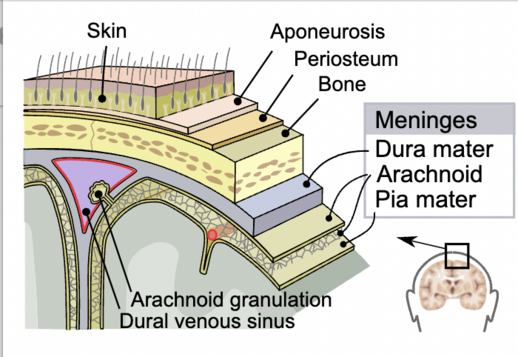Meninges
Original Editor - Lucinda hampton
Top Contributors - Lucinda hampton and Rucha Gadgil
Introduction[edit | edit source]
The meninges is a layered unit of membranous connective tissue that covers the brain and spinal cord. They envelope the central nervous system (CNS) structures so that they are not in direct contact with the bones of the spinal column or skull.
- There are three layers from superficial to deep the: dura mater; arachnoid mater; pia mater.
- Each layer of the meninges serves a vital role in maintenance and function of the central nervous system[1].
Location[edit | edit source]
The meninges can be located by anatomical position.
- The portion that surrounds the brain is the cranial meninges.
- The spinal meninges surrounding the spinal cord and the cauda equina.
Structure[edit | edit source]
Both cranial and spinal meninges are broken down into three layers.
- Dura mater: the outermost layer, directly underneath the skull. It is tough, fibrous and inextensible. It consists of two layers, periosteal and meningeal. Compartmentalises the brain (via falx cerebri and tentorium cerebelli) thus preventing directional movement of the brain within the cranial vault. In the spinal cord the dura mater is stabilised by attachments to the tectorial membrane, posterior longitudinal ligament on the body of the axis vertebra and anterior and posterior spinal nerve roots, which pierce it segmentally and give lateral projections after they exit[2].
- Arachnoid mater: the middle layer, lies directly beneath the dura mater. It is translucent and pliable. Maintains a barrier between the pia and dura mater, creating the subarachnoid space containing the cerebral arteries (that supplies oxygenated blood to the brain parenchyma) and CSF (that provides a cushion for the brain).
- Pia mater: the innermost layer of the meninges, relatively very thin and fragile. Adherent to the surface of the brain and spinal cord following the gyri (ridges) and sulci (furrows) of the brain’s surface. Has perforations which allow the subarachnoid arterial supply to reach the brain parenchyma.[3].
Function[edit | edit source]
The meninges functions primarily to protect and support the CNS , forming a protective barrier safe guarding the sensitive organs of the CNS against trauma. The meninges:
- Deliver blood to CNS tissue via many blood vessels.
- Produces cerebrospinal fluid (CSF), the clear fluid that fills the cavities of the cerebral ventricles and surrounds the brain and spinal cord. CSF protects and nourishes the nervous tissue, acting as a shock absorber, circulating nutrients, and by getting rid of waste products[1].
Disruption of these functions can cause reversible and irreversible damage to the brain parenchyma.[3]
Spaces[edit | edit source]
There are two potential spaces in the skull:
- Epidural (extradural) space: between the bone of the cranium and outer layer of the dura mater. This is in contrast to the epidural space of the spinal cord which contains epidural fat, lymphatics, blood vessels, and nerve roots. The two spaces are not continuous.
- Subdural space: between the inner layer of the dura mater and the arachnoid mater. It’s a thin layer, with some suggesting it’s filled with fluid.
There is one CSF-containing real space:
- Subarachnoid space, between the arachnoid and pia mater, the innermost layer of the meninges. Filled with cerebrospinal fluid (CSF), allowing major blood vessels to pass. In areas where the innermost layer completely separates from the middle layers, it has projections called cisterns[4].
Resources[edit | edit source]
- bulleted list
- x
or
- numbered list
- x
References[edit | edit source]
- ↑ 1.0 1.1 Thought Co Meninges Available:https://www.thoughtco.com/brain-anatomy-meninges-4018883 (accessed 4.5.2022)
- ↑ Radiopedia Spinal Meninges Available:https://radiopaedia.org/articles/spinal-meninges-1?lang=gb (accessed 4.5.2022)
- ↑ 3.0 3.1 Geeky medics Meninges Available:https://geekymedics.com/meninges/ (accessed 4.5.2022)
- ↑ Very well health Meninges Available: https://www.verywellhealth.com/meninges-anatomy-function-conditions-5190214 (accessed 4.5.2022)








